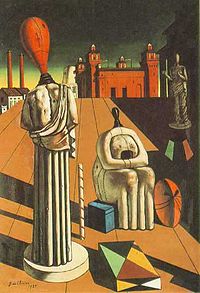Metaphysical painting

Metaphysical painting(Italian:pittura metafisica) ormetaphysical artwas a style of painting developed by the Italian artistsGiorgio de ChiricoandCarlo Carrà.The movement began in 1910 with de Chirico, whose dreamlike works with sharp contrasts of light and shadow often had a vaguely threatening, mysterious quality, "painting that which cannot be seen".[1]De Chirico, his younger brotherAlberto Savinio,and Carrà formally established the school and its principles in 1917.
Development
[edit]
Giorgio de Chirico, unlike many artists of his generation, found little to admire in the works ofCézanneand other French modernists, but was inspired by the paintings of the SwissSymbolistArnold Böcklinand the work of German artists such asMax Klinger.[2]His paintingThe Enigma of an Autumn Afternoon(c. 1910) is considered his first Metaphysical work; it was inspired by what de Chirico called a "revelation" that he experienced in Piazza Santa Croce in Florence.[3]In subsequent works he developed a disquieting imagery of deserted squares, often bordered by steeply receding arcades shown in a raking light. Tiny figures in the distance cast long shadows, or in place of figures there are featureless dressmakers' mannequins. The effect was to produce a sense of dislocation in time and space.[4]
In 1913,Guillaume Apollinairemade the first use of the term "metaphysical" to describe de Chirico's paintings.[5]

In February 1917, theFuturistpainter Carlo Carrà met de Chirico inFerrara,where they were both stationed duringWorld War I.Carrà developed a variant of the Metaphysical style in which the dynamism of his earlier work was replaced by immobility, and the two artists worked together for several months in 1917 at a military hospital in Ferrara.[6]According to art historian Jennifer Mundy, "Carrà adopted de Chirico's imagery of mannequins set in claustrophobic spaces, but his works lacked de Chirico's sense of irony and enigma, and he always retained a correct perspective".[6]After an exhibition of Carrà's work in Milan in December 1917, critics began to write of Carrà as the inventor of Metaphysical painting, to de Chirico's chagrin.[6]Carrà did little to dispel this idea inPittura Metafisica,a book he published in 1919, and the relationship between the two artists ended.[5]By 1919, both artists had largely abandoned the style in favor ofNeoclassicism.

Other painters who adopted the style includedGiorgio Morandiaround 1917–1920,[7]Filippo de Pisis,andMario Sironi.[5]In the 1920s and later, the legacy of Metaphysical painting influenced the work ofFelice Casorati,Max Ernst,and others.[5]Exhibitions of Metaphysical art in Germany in 1921 and 1924 inspired the use of mannequin imagery in works byGeorge GroszandOskar Schlemmer.[5]Many paintings byRené Magritte,Salvador Dalí,and otherSurrealistsmake use of formal and thematic elements derived from Metaphysical painting.[5]
Between the two World Wars in Italy there were numerous architectural vulgarisations of the metaphysical poetics of the "Piazza d'Italia", whose timeless atmosphere seemed to be congenial to the propaganda needs of the time. Squares of metaphysical flavor were built in the historical centers, as in Brescia or Varese, or in newly founded cities, such as those of the Agro Pontino (Sabaudia,Aprilia), to culminate in the spectacular unfinishedEUR in Rome.
References
[edit]- ^Conway Morris, Roderick (9 February 2007)."De Chirico: Painting landscapes of the mind".International Herald Tribune.Retrieved11 April2020– via The New York Times. Also available from thepersonal website of the author.
{{cite news}}:External link in|postscript= - ^Cowling, Elizabeth; Mundy, Jennifer (1990).On Classic Ground: Picasso, Léger, de Chirico and the New Classicism 1910–1930.London: Tate Gallery. p. 71.ISBN1-85437-043-X
- ^Holzhey, Magdalena.Giorgio de Chirico.Cologne:Taschen,2005, p. 16.ISBN3-8228-4152-8
- ^Onians, John.Atlas of world art.Laurence King Publishing, 2004. p. 288. Web. 07 Oct. 2011.
- ^abcdefGale, Matthew. "Pittura Metafisica".Grove Art Online. Oxford Art Online.Oxford University Press. Web.
- ^abcCowling, Elizabeth; Mundy, Jennifer (1990).On Classic Ground: Picasso, Léger, de Chirico and the New Classicism 1910–1930.London: Tate Gallery. p. 52.ISBN1-85437-043-X
- ^Morandi, Giorgio (1988).Morandi.New York: Rizzoli. p. 141.ISBN0-8478-0930-7
